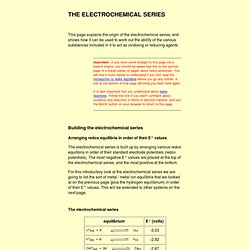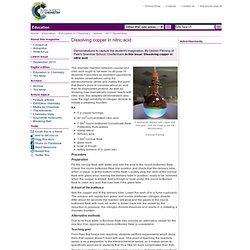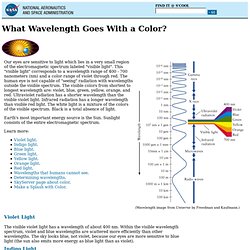

Video: Paper, TLC and Column Chromatography. The electrochemical series. Arranging redox equilibria in order of their E° values The electrochemical series is built up by arranging various redox equilibria in order of their standard electrode potentials (redox potentials).

The most negative E° values are placed at the top of the electrochemical series, and the most positive at the bottom. For this introductory look at the electrochemical series we are going to list the sort of metal / metal ion equilibria that we looked at on the previous page (plus the hydrogen equilibrium) in order of their E° values. This will be extended to other systems on the next page. Dissolving copper in nitric acid - Exhibition chemistry - EiC Nov 2011. Demonstrations to capture the student's imagination, By Declan Fleming of Pate's Grammar School, Cheltenham.

In this issue: Dissolving copper in nitric acid The dramatic reaction between copper and nitric acid ought to be seen by all post-16 students. It provides an excellent opportunity to explain observations using the electrochemical series and makes the point that there's more to consider about an acid than its dissociated protons. As well as showing how dramatically copper reacts with nitric acid, this adapted demonstration also uses the high solubility of nitrogen dioxide to initiate a pleasing fountain. Kit 5 g copper turnings 40 cm3 concentrated nitric acid 1 dm3 round-bottomed borosilicate flask.
Procedure Preparation Fill the conical flask with water and add the acid to the round-bottomed flask. What Wavelength Goes With a Color? Colors We Can't See There are many wavelengths in the electromagnetic spectrum the human eye cannot detect.

Energy with wavelengths too short for humans to see Energy with wavelengths too short to see is "bluer than blue". Light with such short wavelengths is called "Ultraviolet" light. How do we know this light exists? Energy with wavelengths too long for humans to see Energy whose wavelength is too long to see is "redder than red". Free Range Chemistry 02 Coffee Delicious Chemicals.
Scientific principles of titration. Chapter 6. The Reliability of Data in Quantitative Chemistry. Chapter 6.

The Reliability of Data in Quantitative Chemistry How to recognize errors: systematic, random and gross Systematic errors In a most idealized sense, a value which has been determined experimentally is one element of a population with a normal distribution. If the method produces a result which is an acceptable reflection of reality, that is, if it really works and gives result which reflects that which is known by some other independent analysis, then one says that this method does not produce a significant systematic error. If the first method through repeated comparison with independent methods of analysis becomes a preferred method because it can be shown to be (1) as precise as could be expected by the instrumentation used and (2) that it yields values as close to the true value as the precision of the method, then one might argue that µ A is indistinguishable from the true value.
Where might one encounter such systematic error? Constant Errors Exercise 6-1 (a) 0.8000 g and. Chemistry International. Vol. 35 No. 3 May-June 2013 by Ilya Kuselman and Ales Fajgelj Out-of-specification (OOS) test results of chemical composition are results that fall outside the specifications of acceptance criteria established in the pharmaceutical industry, or do not comply with regulatory, legislative, or specification limits in other industries and fields, such as environmental and food analysis.

Investigation of OOS test results is described in the U.S. FDA (Food and Drug Administration) Guidance 2006.1 The guidance established an empirical organizational approach to investigation and decisions, which can be utilized at the different stages of investigation. When an OOS test result is identified, it is important to determine the root causes of the event and to avoid reoccurrence of such results. However, it is known that human activity is never free from errors: about 70 percent of incidents and accidents are caused by human errors. U.S. Page last modified 3 June 2013. Workshop on Human Errors and Out-of-Specification Test Results. For the Chairman invitation letter please click here Organizing committee of the workshop: Sponsored by: Introduction to investigating out-of-specification test results and human errors in analytical chemistry Dr.

Scientific principles behind chromatography. Scientific principles behind reflux. Scientific principles behind solvent extraction. What is the principle behind the process of solution and filtration as a mean of separation? - Yahoo Answers.